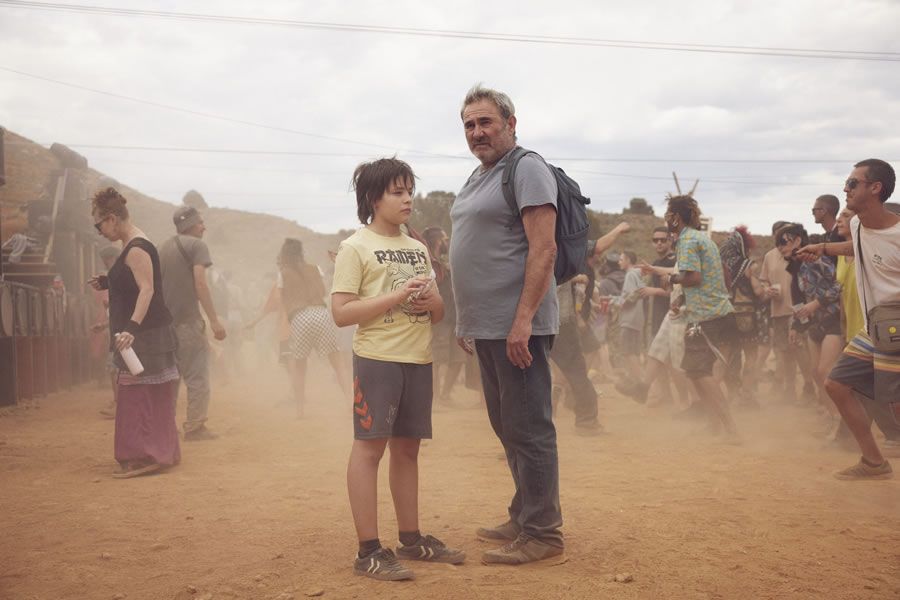Amidst the mayhem of queuing for a gala premiere at Cannes, I decided to take a break to catch a screening of Oliver Laxe’s buzzworthy Sirât. Oliver Laxe is a filmmaker whose work I was unfamiliar with before this screening, which allowed me to enter this screening with zero expectations. What ensued was an unforgettable theatrical viewing experience that left me completely satisfied as I sat and stared at the silver screen for almost 2 hours. Not once did my mind wander, nor did I begin to twiddle my thumbs due to boredom. Although I was entertained to the extent I was as a 14-year-old watching Avengers: Endgame on opening weekend, the second the credits began to roll, confusion and frustration flooded over me. This Cannes selection is the arthouse equivalent of a film like Mad Max: Fury Road or the Terrifier series—once you sit with it and peel back the milieu, it becomes evident that this neo-road-thriller lacks in writing what it wows in its editing and sound design, which makes Sirât play out like some artsy form of torture porn.
Sirât opens with a quote that equates the word “Sirât” to the bridge between heaven and hell. From there, we open on various figures setting up giant subwoofers in the middle of a barren desert landscape. As the opening titles roll, we see bodies fill these spaces as they move freely, as minimalist rave music plays. Immediately, the viewers are filled with questions such as “Where are we?”, “Who are these people?”, “When does this take place?”, or “Why are they in the desert?”. All of these questions seem simple enough for any abstracted film opening sequence, but as we spend the rest of the film with these people in the same setting, it becomes apparent that we never get sufficient answers to these questions. The central story of Sirât follows Luis (Sergi López) and his son Esteban (Bruno Núñez), who are in the desert in search of their missing daughter/sister, who was supposedly a frequent member at these desert raves. The military shuts down the first rave due to some distant warfare, which causes everyone to evacuate. Luis and Estaban decide to go off the general caravan’s path to follow a group of ravers who showed the father-son duo kindness earlier in the film. The rest of the film contains Luis and Estaban’s journey with the ravers across the desert to an unnamed destination, which features many twists and turns, many of which will upset viewers. I advise those who plan to watch this film to stop reading here, as Sirât is a film that is dependent on shock value for enjoyment.

As a narrative, the writing is extremely thin. So many ideas are planted in the opening or throughout the middle section of the film, just for everything to be put on hold at the midpoint. In the middle of the film, Estaban and his cute dog fall off a cliff and die when Luis is helping do mechanical work on one of the raver’s vehicles. Before this event, we learn very little about Luis and Estaban’s relationship. We know Luis is a loving father who desperately wants to find his daughter while ensuring his son’s safety, but that’s about as deep as it goes. As for Estaban’s character, he is simply written as a joyful kid who loves his dog and is pretty brave. Luis’ character is textbook good father, and the entire crew of ravers has very little personality other than the fact that they all love raving and that some of them are more immature than others. Before the midpoint, the only characters you truly care about are Estaban and his cute dog Pipa. It is a bold choice on Laxe’s behalf to kill the only two characters many audience members bonded with so early in the film, but it doesn’t feel in service of the characters. Up until this point, Luis’ main internal conflict was whether he would be able to accept his daughter’s lifestyle choices (desert raves) if he were to find her, but now it turns into whether he will be able to grieve his dead son. Given the allusion to war earlier in the film, by killing the two most likable characters so early on, Laxe can make some sort of commentary on war’s ability to seemingly rip away people’s lives without any reason. However, the film still seems to be convinced that it’s about the community grieving and the benefits of desert raves, which is what we witness shortly after.
The rest of the film follows Luis’ struggles to cope with the death of his son and the raver’s ability to bond with Luis and show him how to use desert raves to help him grieve. Perhaps Luis’ internal need in the whole film was to process the loss of family, but by killing Estaban in service of Luis fulfilling his need, it plays like a selfish emotional exploit on the writer’s behalf. Once we reach a moment of relief for Luis—he joins in on a rave and yells out in anguish for the loss of his son—it is immediately ripped away as one of the ravers explodes, and it is revealed that they are stranded in a minefield. The crew traverses the minefield in a scene that feels pulled from Spike Lee’s Da 5 Bloods as characters get killed off one by one. In the end, Luis and two others escape on some sort of train, but it lacks any sort of celebratory feelings or triumph. Instead, a simple exhale as a viewer is all that was granted: “At least Luis didn’t die” is all that we can say. I am all for writers taking risks in writing, but these risks must be earned by being in service of the film’s central message. The central message is the benefit of community grieving, but it’s hard for me to say that the message lands when the credits roll. The central message is diluted by so many red herrings and plants without pay-offs in this film that by the end, you don’t gather any sort of meaning from the story other than “that was messed up”. Sirât doesn’t earn its character deaths due to its under-developed characters which is why watching an innocent boy, and his dog die feels more like torture porn than cinematic storytelling.

Sirât does shine in its visual language that is unique and in service of its landscape. The film was shot on Super 16mm film by cinematographer Mauro Herce. The haziness of the film, combined with the sandstorms and booming bass music, creates a one-of-a-kind vibe that is unique and central to the film’s critical success thus far. Although Herce composes his shots in service of both the characters on screen and the landscapes surrounding them, there are a couple of strange shot compositions, such as one in which we see one of the ravers with a prosthetic leg march along the asphalt for a prolonged period of time. Shots like these appear very intentional, but it is unclear the message they are relaying. The music is composed by Kangding Ray, and the entire score is so barren, but filled with bumping bass. In the post-Challengers landscape, it is refreshing to see more films use the power of club music to set the scene. Feeling the room shake throughout the screening was such a unique experience—the whole time, I would nod my head along to the music. It is extremely restrained and ambient, even though it is such an integral aspect to the story.
The visual language at points feels similar to the work of Harmony Korine, Ryusuke Hamaguchi, and even Jonathan Glazer, who are masters at playing with form to serve their characters’ state of mind, but the film does not commit fully to its visual style like the films of these directors do. Sirât often breaks its own visual rules in service of the story, such as to have deep scenes of confession or moments of reflection amongst characters that almost seem like they are pulled from another film completely. For example, the scene where Luis and Estaban think they are being abandoned at a river goes full Mad Max or Friedkin’s Sorcerer. Other scenes, such as Tonin’s (Tonin Janvier), one of the ravers, leg puppet show, do not seem to belong in this film. All in all, for Sirât to truly flourish, it should have either focused on its character development or the aesthetic style, as they both land in moments, but not as a whole, realized project.
I love a movie that takes visual risks. Last year’s The Apprentice and I Saw the TV Glow were able to blend characters and visual aesthetics that felt in service of the film’s central messages. The Apprentice sought to show how any human being can be turned into a machine of success and immorality, and by using 80s newscast visual language, it created a sense of verisimilitude and urgency that benefited the message. I Saw the TV Glow explored how media allows us to explore and experience parts of ourselves that we repress, and its barren and empty shots of reality mixed with the action of the fictional media immersed us as a viewer into the main character’s experience. Sirât aims to explore how communal grieving and found families can help us explore and process our trauma healthily and attempts to use the visual aspects of desert and rave culture to explore this, but its unwillingness to commit to one narrative aesthetic buries the central message in the jumble of a movie that it is.
Often, films try to handle more than they can chew in their 120-minute runtime. I think of Emerald Fennell’s Saltburn, a film that tries to explore class, power, and greed, but all that is ever discussed about that film in the zeitgeist is the absurdity of the character’s decisions and the shocking scenes such as a man humping a grave or the infamous “I’m a vampire” scene. Sirât feels very much like this year’s Saltburn—lacking a true narrative goal or message, viewers will discuss the shocking nature of some of the scenes instead of truly being immersed in the work or walking away with a new understanding of humanity. I’m all for killing off the viewer’s favorite characters early on, but the rest of the film must earn it by getting the message across. Even after thinking back to the film to write this review, I still am not sold on Sirât’s message of raves as communal bonding. Perhaps, the only thing to gather from this film is that if you are stuck in a minefield and your friends keep exploding, at least you’re not alone.

